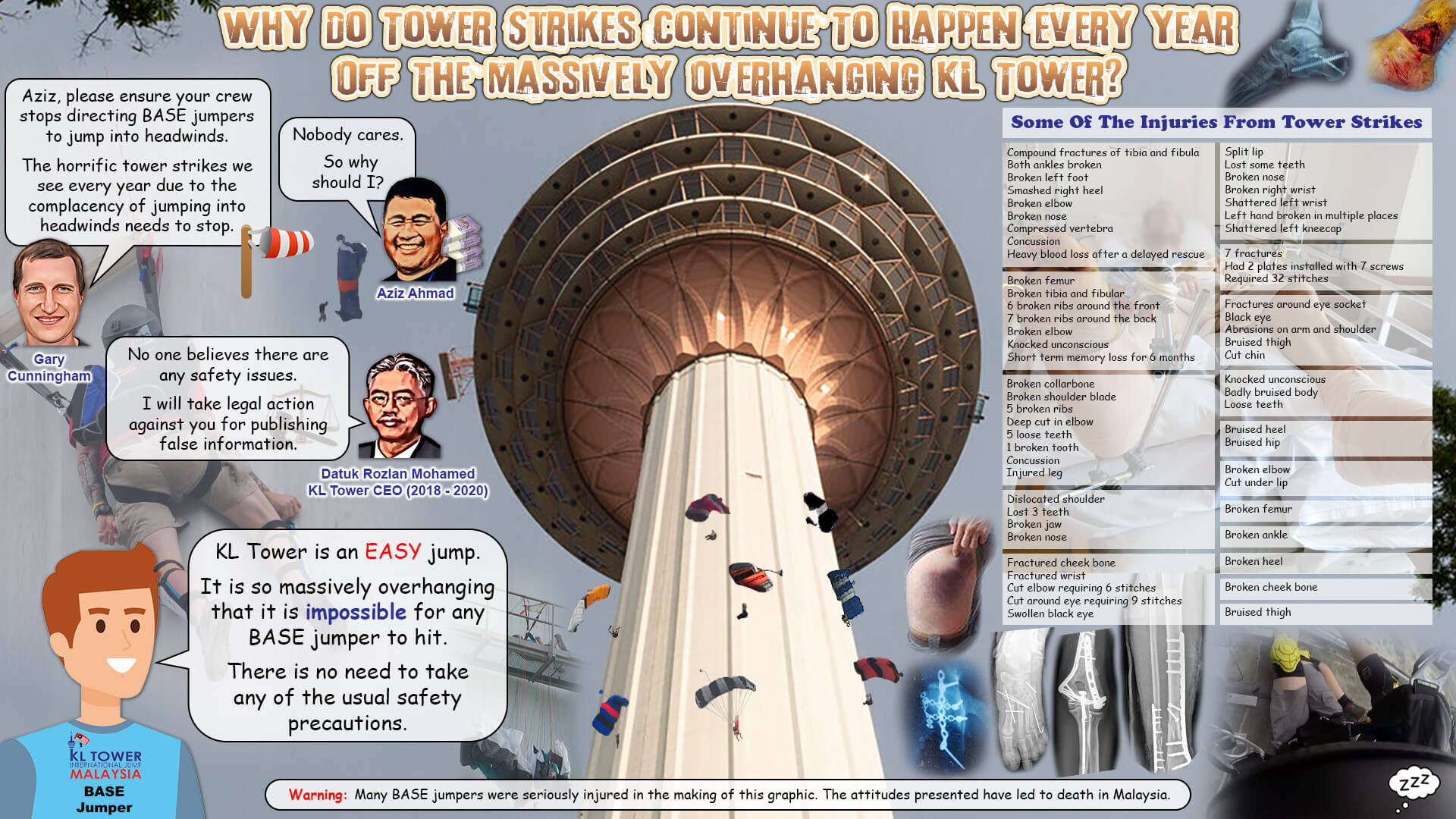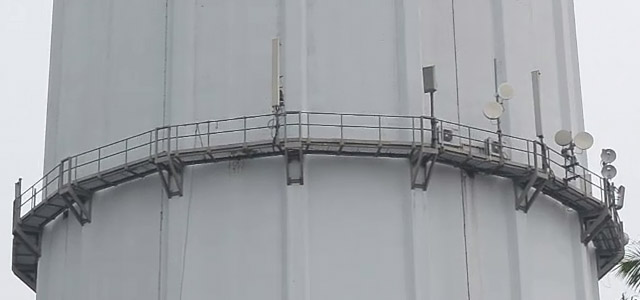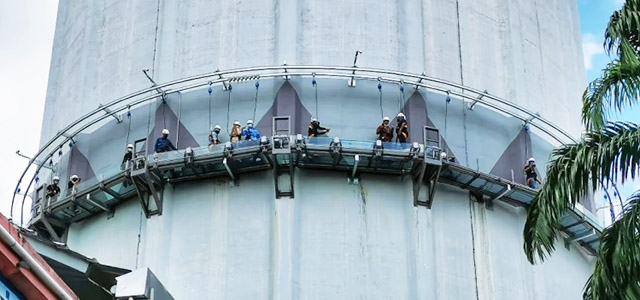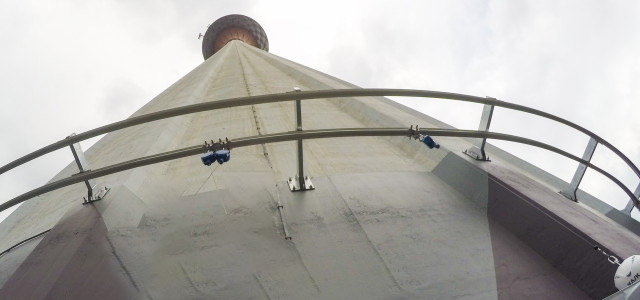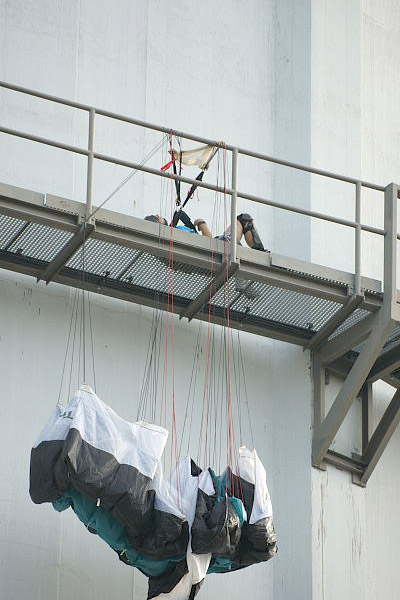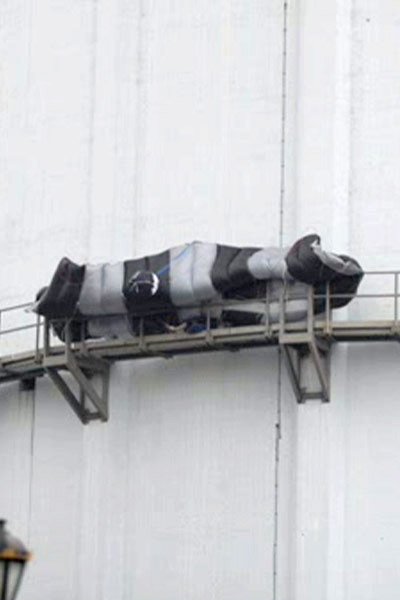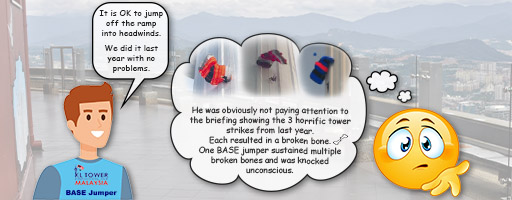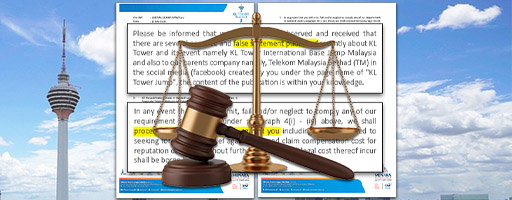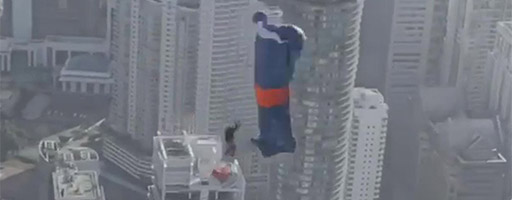New Attraction At KL Tower Potentially Deadly To BASE Jumpers
By Gary Cunningham
In November 2021 KL Tower introduced a new attraction named Tower Walk 100. It is an exposed platform encircling the tower shaft 100 feet off the ground, located at level T02. Part of the platform is transparent with visual and audio effects of it cracking as you walk over it.
While it is a fun attraction for some KL tower visitors, there is the potential that the alterations made at level T02 for Tower Walk 100 could end up being deadly for a BASE jumper. Most likely KL Tower and their novice BASE jumping event organisers will overlook the potential new issue of Tower Walk 100, dismissing it as a nonissue and unlikely to ever cause a problem. But the chances of a BASE jumper hitting it is very real and guaranteed at some stage.
Why Is The Tower Walk 100 Potentially Deadly To BASE Jumpers?
Previously at level T02 was a fenced catwalk that was not open to the general public. When BASE jumpers crashed into KL Tower, if they were unable to turn their parachute away from the tower shaft, they would continue sliding down it, often crashing into it multiple times before crashing into the catwalk at level T02. Usually, they would sustain serious injuries and sometimes be knocked unconscious after crashing into the tower shaft or the catwalk. The fence around the catwalk would prevent them from falling any further.
The obvious added danger of the Tower Walk 100 are the rails installed above the catwalk. These rails are the attachment point for the ropes connected to the harnesses used by all visitors to the Tower Walk 100. It is a safety feature to prevent visitors from falling off the side of the platform 100 feet to the ground. If a BASE jumper slides down the tower shaft and hits these rails then it is possible for them to sustain more severe injuries. It is envisaged that a leg could easily snap if it gets trapped between the rails. But that is not the main added danger.
If a BASE jumper hits the rails and it temporarily halts their fall for a fraction of a second, that gives their parachute a chance to fall below them. When the BASE jumper bounces off the rails, if their parachute has become unloaded and fallen below them, then it can end up in a tangled mess. The BASE jumper could even fall into their parachute. The result would be the BASE jumper accelerating into the ground 100 feet below with an uninflated parachute and a high chance of death.
This is the same way Malaysian BASE jumper Azuan Taharudin died when he crashed into the horizontal fins of the Ministry of Women, Family and Community Development (KPWKM) building in Putrajaya in January 2021. Crashing onto one of the building’s horizontal fins halted his fall for about half a second. It was enough time for part of this parachute to fall below his level. Once he rolled off the horizontal fin and reached line stretch, his parachute did not fully reinflate and remained a tangled mess. His impact on the ground was not survivable. Knowing the average rate of building strikes at Malaysian BASE jumping events, it had been previously calculated that the features of the KPWKM building would practically guarantee a death there within 500 BASE jumps. A prediction that proved to be deadly accurate despite strong denial from all involved. 500 jumps is equivalent to just half a day of jumping at a typical KL Tower event. Fortunately, the expected death-to-jump ratio at KL Tower is much lower.
There is also the chance that a BASE jumper could slam into a visitor at Tower Walk 100 which could also leave the visitor seriously injured.
What Are the Chances Of A BASE Jumper Hitting The Tower Walk 100?
Since a few BASE jumpers have crashed into the catwalk at level T02, it is guaranteed that sometime in the future a BASE jumper will hit the Tower Walk 100.
At least 3 BASE jumpers have crashed into the catwalk at T02 during KL Tower BASE jumping events over 20 years, all ending up seriously injured. This corresponds to the chances of a BASE jumper hitting the Tower Walk 100 at any one event to be at least 15%. There have possibly been maybe one or two more BASE jumpers who have crash-landed on the catwalk after hitting the tower but have not been so badly injured. Records during some of the years were poorly kept so it is unknown how many BASE jumpers have ended up there. So the chances of a BASE jumper hitting Tower Walk 100 could possibly be higher than 15% at an event.
Previous injuries sustained after crashing into KL Tower and then crashing into the catwalk at level T02 include the following:
- Dislocated shoulder
- Broken nose
- Broken jaw
- Lost 3 teeth
- Compound fractures of tibia and fibula
- Both ankles broken
- Broken left foot
- Smashed right heel
- Broken elbow
- Broken nose
- Compressed vertebra
- Concussion
- Heavy blood loss after a delayed rescue
- Fractures around eye socket
- Black eye
- Abrasions on arm and shoulder
- Bruised thigh
- Cut chin
How To Avoid Crashing Into Tower Walk 100?
The first step in avoiding hitting the Tower Walk 100 is to not hit KL Tower. Do not be fooled into believing that being a massively overhanging object makes KL Tower almost impossible for a BASE jumper to hit. Up to 3 BASE jumpers have hit it at each event. There has only been one event in the past 20 years where a BASE jumper has not hit KL Tower. So it is quite common and very easy for a BASE jumper to hit it.
If you do hit KL Tower you need to turn your parachute away from the tower to avoid sliding all the way down it and crashing into the Tower Walk 100. This is not always possible if you have been knocked unconscious, or are slightly stunned or injured when hitting the tower, or if you have hit the tower at a relatively low height. Spinning up into line twists before or after impact with the tower can also make it extra difficult to turn your parachute away from it.
If you have already been knocked unconscious from hitting the tower, you can only hope that having a limp body will reduce the severity of further injuries on impact. At least you will not feel it at the time.
If you are sliding down the tower shaft and are unable to get away from it before you get to Tower Walk 100, the best option is to try to kick off the tower just before you reach the rails and swing out to avoid hitting any feature of the Tower Walk 100. Then pray that part of your parachute gets snagged up on it. If not, you will be soon hitting the upper ground floor roof with a chance of sustaining more injuries, or even being killed. There have been a few people that have ended up on the upper ground floor roof with multiple broken bones and/or knocked unconscious when striking infrastructure install on the roof.
More About Tower Strikes And How To Avoid Them
In theory, tower strikes should be easy to prevent. It was a very long learning curve to learn all the reasons that tower strikes continued to happen every year at such a massively overhanging tower. We observed there was always a very strong level of resistance from BASE jumpers, so-called event safety contractors, and some KL Tower management to implement and adhere to the basic safety precautions that would easily eliminate the majority of tower strikes. This is due to the strong level of complacency and denial that all entities had.
The first step in avoiding a tower strike is to not become complacent or be in denial about the potential to have a tower strike. It has been consistently proven that it is very easy for a BASE jumper to hit KL Tower while ignoring basic safety guidelines.
The number one rule in avoiding a tower strike is to never jump into a headwind no matter how light it is. This includes any wind blowing towards the tower at a shallow angle which is often dismissed as almost a crosswind. If you get a major off heading opening then any headwind will help to quickly accelerate you into the tower.
Do not follow the instructions of the untrained safety crew who often naïvely guide BASE jumpers to jump into headwinds. Yes, the entry fees BASE jumpers are charged go towards paying locals that pose as safety crew who will guide you to jump in a manner that guarantees someone will hit the tower. It is a rort of local event contractors.
Do not be a sheep and follow other BASE jumpers who are jumping into headwinds. Many people often get away with it for a while, but when BASE jumpers have started jumping into headwinds it has always guaranteed that someone will hit the tower.
Jumping into a headwind can easily be avoided by moving around the tower until you are at least in a crosswind. However, it is not always black-and-white. The wind to be concerned about is the wind at opening height, which is not always the same as the wind at the launch point level, or at ground-level. The wind also often changes in strength and direction. When the winds waivers between a cross wind and blowing to towards the tower at a shallow angle, BASE jumpers often become complacent and continue jumping it what has become a slight headwind.
If you are concerned about not being able to make it to the main landing area when jumping from a more appropriate point around the tower with regards to the wind, then make an early decision, or preferably a decision before you jump, to land at an alternative landing area behind the tower if the wind is blowing in that direction.
The only year that there have been no tower strikes at the KL Tower BASE jumping event was in 2017. I made extra efforts that year to neutralise the negligence of new KL Tower management and event contractors. The most significant problem was that they would hire so-called safety crew that had no knowledge, skills or training who would naively encourage BASE jumpers to jump in a manner that guaranteed tower strikes would happen. Successfully eliminating tower strikes from the event only resulted in me being expelled from the event. KL Tower managers and their event contractors were determined to eliminate the wealth of knowledge and do everything known to bring back a record number of tower strikes and other incidents. It was a repeat of the same sequence of events that led to the first death in Malaysian BASE jumping several years prior. As expected, with the new KL Tower management promoting a high level of negligence, it did not take too long for another death in Malaysian BASE jumping to eventuate. All involved remained in strong denial of all the warnings given.
